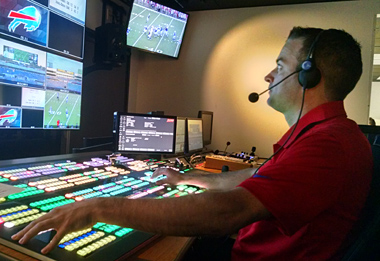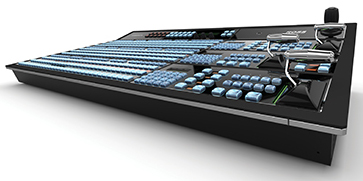Production Switchers in the IP/4K Era: A Conversation with Les O’Reilly

Ross Video Acuity A3 production switcher control surface
ALEXANDRIA, VA.—Video production switchers have always been large and complicated, but they are now more capable and complicated than ever. Manufacturers have done wonderful things to make the human-switcher interface usable in today’s products, as that one device can create titles, roll in video, control cameras, provide studio automation and, yes… switch between sources.
One company building production switchers is Ross Video, which has grown in recent years to include related technology such as studio automation. To learn about the state-of-the-art in production switchers and how they fit into the modern studio, BE Extra spoke to Les O’Reilly.
Les is Ross Video’s technical marketing product manager for switchers and the company’s openTruck product. He has been in the broadcast industry for 13 years, and stays active in the production side of the business as a technical director for many sports productions.
BE Extra: With HDR, 4K, IP video and other technologies making industry headlines, what do you concentrate on as a manufacturer? What technology do you build into a switcher today and what do you leave for the future?
O’Reilly: With all technology, you need to make sure that you’re moving forward but at the pace that the industry is able to move with. We can’t get too far ahead of what the industry wants. 4K or UHD is being used in very limited applications and does not seem to be high on the list of the majority of our customers. However we do have some interest and requirements, and that is why we developed Quad-Link 1080p3G over SDI. As the manufacturers of cameras and replay machines (for live sports) begin to develop a single-cable solution, we should also be moving into that 12G single cable solution and continuing to offer as many processing resources as possible.
IP Video is another item that is a little stretched at this time as well. There are no actual cost savings in the IP domain, but rather a cost increase with the required infrastructure to go around it. If we just look at using SMPTE 2022-6 standard, which is essentially SDI-over-IP uncompressed, then you’re trading in one cable type for another but having to implement new interfaces. To process video like a production switcher does, you can’t do this in the packet domain. You need to bring all the video together so that you can process it. You’re also not going to see a switcher that is all IP-in and all IP-out, as too many devices are still in the SDI domain. Hybrid systems will be what we see developed over time, with some inputs in the IP domain and other in the SDI domain. The other issue is standards, as not all IP is the same. Some vendors have proprietary standards that require licenses and proprietary chips; this moves the industry away from a standard interconnect protocol that we have had with SDI and will cause increased cost.
Get the TV Tech Newsletter
The professional video industry's #1 source for news, trends and product and tech information. Sign up below.

Les O’Reilly
BE Extra: Speaking of IP video, what’s something desirable that you can do with an IP switcher that you can’t do (or is much harder to do) with SDI? How about the other way around: Is there something easily done with SDI that’s hard to do with IP?
O’Reilly: From a production switcher application, there really is nothing that an IP input can offer that is superior to an SDI input. An IP video input needs to be processed, so an SDI input is actually less expensive. With SDI, we avoid decoding the input stream and avoid having to re-encode the video into packets for an IP output. SMPTE 2022-6 is just SDI-over-IP, which does not gain us much.
One advantage about SDI is that you can plug it into a DA and get copies of it out, then put those into a router and production switcher at the same time. I am always going to want my cameras to be in the router and the switcher. One comment that a customer made to me was, “When did you hear about a hacker getting into your SDI infrastructure?” Funny comment but it is something to think about. SDI is secure and a cost-effective medium currently that is not able to be displaced as easily as some thought.
BE Extra: Switchers used to simply switch. Now, they can do graphics, titles, motion video feeds and even have camera controls. Obviously someone has to operate the switcher, so what is done to make such a product usable by a single operator? Can the user interface be made simpler still?
O’Reilly: These additional features allow the use of macros or custom controls to integrate all this together in repeatable events. They allow the operator to create complex scenes that can be recalled at the press of a single button. The user interface is actually already being advanced for some of these things. Products like OverDrive lead the Automated Production Control environment and give an APC overview and control. This allows a single operator to control this from a single UI that is run-down based.
We also introduced the ViewControl user interface that puts the video and controls onto a touchscreen and makes things more visual and easier to process for many users. However there will always be a need for the hard control surfaces. More than ever we hear the phrase, “I want more buttons,” and that is just because users want more dedicated functions on buttons to make fast-paced operation easier.
BE Extra: Everything connects to the Internet today. What is Ross Video doing to prevent unauthorized access to its components? Is that enough?
O’Reilly: Network security is handled well by the IT professionals that that our customers have. With the push for inter-connectivity and control, it is hard to make these systems communicate and be 100-percent secure. We focus on the devices that need access to the outside world to have multiple network ports. This way it is easy for the control network to be left on an island that is not connected to the Internet, while the second side of the device can have access to the outside world on a different network. This makes it very easy to get the internet data needed, while keeping that potentially exposed network separate from your control and systems network.

Ross Video Carbonite Black switcher
BE Extra: For the most part, switcher control panels have lots of buttons that do certain things. The buttons can be reprogrammed, but there are still lots of physical buttons. Is there any interest in a switcher that uses a large touchscreen controller that can be completely reconfigured for different operators and different operations? Is anyone using anything like this?
O’Reilly: We do offer a product called ViewControl with our Carbonite series—it is a giant configurable touchscreen. It allows operators to control the production and watch the video at the same time. With an easy-to-use interface and the ability to load a new show, this works really well. However this is not as powerful as using a physical control surface and does not lend well to “on-the-fly” changes to the production or the effects, and that is where the panel will always be needed.
A touchscreen panel replacement is also hard since you do not have physical buttons to have your fingers on while you’re looking up at the video screen. This is where TDs have the most control, as they can feel their way around the panel and know what they are pressing and the result.
BE Extra: What else should we know about switchers and their future?
O’Reilly: Switchers are used to process live video in real time with less than a line of delay. This is a demand that is required for live events and real-time productions. As the data rates scale up, so do the switchers and the processing. Features and workflow improvements however are software implementations. We are constantly working on new features and improvements, and usually off these to existing customers, thus allowing us to improve the product in the field. In many cases, the feature set and functionality can be “upgraded” with next release just by downloading the software.
Advancements in production switchers are driven heavily by users who send in requests for new features and workflows. These are the ones who push the product to its limit, then tell us, “If it could do X, then that would make it easier for me to do Y, which would make the production that much better.” So the future really is what the users of the products are able to come up with and ask for. We are able to take those requests and make features for future releases, enabling the switcher to have this workflow.
Bob Kovacs is the former Technology Editor for TV Tech and editor of Government Video. He is a long-time video engineer and writer, who now works as a video producer for a government agency. In 2020, Kovacs won several awards as the editor and co-producer of the short film "Rendezvous."

